
|   |

|   |
 e-mail: sunilkothari1933@gmail.com The 36th Natya Kala Conference: Part 2 Photos: Yoga January 4, 2017 4th Day The session opened with V.A.K. Ranga Rao dispelling wrong impression given when he had asked Padma Subrahmanyam to show Karana Valitoru. He said that he did not compare it to cabaret, but such an impression was created because of the hip movement. He reiterated that the text sung for dance must have correct wordings. The session between Nandini Ramani and Swamimalai SK Suresh was illuminating for young generation of dancers. Nandini described how she had received training from the legendary Balasaraswati. She and her gurus Kandappa Pillia and his son K Ganesh held the tradition very high. Fidelity was the key word. The dancer had to stick to one guru, one bani. There were no questions allowed. One had to follow what the guru taught. By osmosis one learnt a lot. The music, the movement, the adavus, the abhinaya with reference to Balasaraswati was exceptional. Bala later on went abroad to teach. But within India it was just remembering whatever she taught. There was no specific methodology. So vast and rich was her repertoire and music that dancers who studied under her feel blessed that they had glimpse of her greatness. Nandini maintained when young dancers asked if they could learn from other gurus, she told them that she also believed in fidelity to one guru and one bani. Suresh was trained in nadaswaram but later on he came to Chennai and under tutelage of Swamimalai Rajaratnam Pillai he learnt a lot and his talent blossomed. Singing, nattuvangam, teaching and performing all helped him to be a much sought after young guru, receiving best of both the worlds. He told young dancers that he would consider himself lucky if he could live up to high standards of his guru and follow the path of excellence. The conversation between Nandini and Suresh was full of mutual respect and both were aware that what their gurus taught them, is priceless and rare and it must be maintained. Times have changed and old times are not going to come back. But what young generation would do well to understand is the values the old guards imparted must be a beacon light for them. 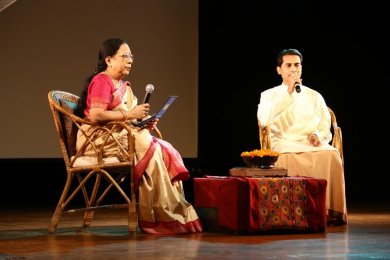 Nandini Ramani and Swamimalai Suresh 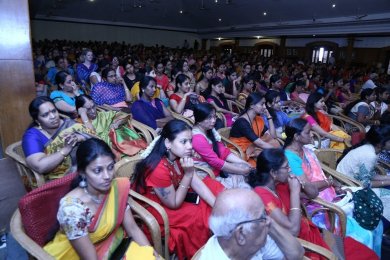 Audience 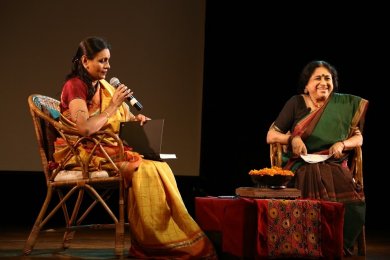 Priyadarsini Govind and Gowri Ramanarayan 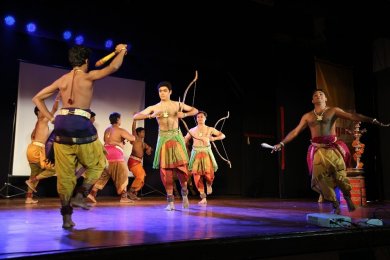 Demo by Kalakshetra Conversation between Priyadarsini Govind and Gowri Ramanarayan was complimentary and threw light on how institutional training was relevant in present times. What Rukmini Devi created is absolutely ideal and what pedagogy Kalakshetra has established is not only ideal but also adaptable by other institutions. Reams have been written and spoken about Kalakshetra and it needs no repetition here. Priyadarsini as an outsider at Kalakshetra in role of an administrator explained well that it is a rare institution which gives one a way of life, offers opportunity to be one with nature, aesthetics, dance, music, philosophy. The training in dance is of high order. It is time proven and has been a shining example for other institutions to follow. She was asked her vision to develop further what is available at Kalakshetra. She spoke of various schemes Ministry of Culture has supported. Like that of outreach programmes, visiting faculty, visits by scholars and dancers, workshops, performances by leading dancers from within India and abroad, exposing present generation to wealth of world culture. In terms of education they are to bring out books for pedagogy of training. Besides regular training other departments of crafts, weaving centre, revival of sarees from the time of Rukmini Devi - in place of three looms now thirteen looms work there - high standard of work, crafts etc. These are few of the agendas which are being carefully followed. Priyadarsini referred to support for the theatre at Kalakshetra which could be world class. She reiterated her faith in Bharatanatyam. As an art form it is capable of uplifting the spirits and offers permanent values. She also said that teachers have to be empowered to teach in best possible manner and all attempts are made to raise the bar. As an institution of national importance Kalakshetra will continue to hold those high standards and the policy there now is of inclusive nature. In order that the young generation may have a glimpse into choreography of Kalakshetra, excerpts of patrapravesh of Hanuman, setubandana sequence and apsaras watching duel between Rama and Ravana, were presented. 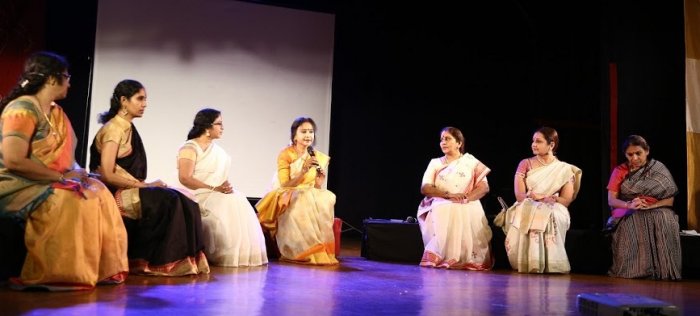 Panel All dancers spoke of their training in earlier times and how they have to adjust to changing times. They said that if the advanced students want to learn from other gurus, at least they should inform the guru, else guru feels hurt. Also they must repeat the item learnt many times during their performances as it is new every time one performs. Ramya Ramnarayan drew attention to difficulties experienced by her as NRI, teaching dance in New Jersey in USA and various challenges she faces there. Anitha Guha, Sheela Unnikrishnan, Parvati Ghantasala with large number of children learning from them spoke of how they have worked out various strategies, organizing dance competitions, inventing games to make dance more of fun and thereby making it enjoyable. Roja Kannan observed that it is indeed a tough decision to make dance a career. Even after 45 years of performing and teaching she feels that dance makes several demands and financially it is still not viable to entirely depend upon dance only. Teaching is a necessary corollary. 5th Day The opening session was 'The Body as Canvass' by Malavika Sarukkai. Her rigorous practice and long hours of rehearsals, understanding the importance of fitness and body as a vehicle to perform dance were emphasised by her. She chose to perform 'Sthiti Gati,' an old choreographic work in Madhuvanti raga, composed by C.V. Chandrasekhar to explain why sadhana was necessary and a dancer had to think in order to create and prepare body for the same. She quoted from A.K. Ramanujam about the treasure trove of songs, what Krishna Chaitanya said, paraphrasing Abhinavagupta about not anukarana, imitation, but anukriti, creation. Poetry, music, dance, mind all have to align and the body as instrument has to be maintained physically, emotionally and psychologically so that dance when performed offers rasa. Body also could be a medium for displaying sensuousness. To depict it she performed a piece from 8th century Kashmiri poet Damodargupta's 'Kuttinamatam' shlokas about a courtesan. The grace, the movement of the body, angikabhinaya all expressed how body displays this quality. One more piece she demonstrated was to show neutrality of gender. In dream, Yudhishtira sees the deer begging him not to hunt and kill them. Malavika said that while composing this work she had her mother watching her rehearsal commenting that suggesting 'deerness' was not coming through. Till it was achieved the rehearsal went on. The sounds of the hoof of deer had to match the music also. 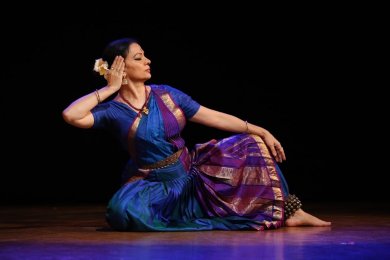 Malavika Sarukkai  Dr. Sheela Nambiar It was followed by Dr. Sheela Nambiar's paper on fitness. Obstetrician, gynaecologist, fitness and lifestyle consultant Sheela Nambiar explained difference between an activity and exercise. She urged dancers to focus on their core to get fitter and stronger. With help of illustrations she explained how injuries are caused and what should be done to avoid it and cure them. Core takes the stress therefore a dancer needs to pay attention to strength training. Dancers need strength, not just in their legs and back, but also in their core as well. Core strength is key to keeping the dancer injury free and to be able to dance gracefully. She urged dancers to have holistic approach to their body and mind. Simply following fads to lose weight and so on should be avoided and instead an honest attempt should be made to holistically develop the body from within. The right nutrition, exercises and practices to maintain the body for dance will help a dancer stay with her passion for longer, injury free. Srinidhi mentioned that dancers who need to take advice and help from Dr. Sheela Nambiar should send e-mail to the conference id. It was one of the highlights of the conference and dancers would benefit following Dr. Sheela Nambiar's advice. Geeta Chandran from Delhi was asked to discuss the economics of classical dance. A multifaceted dancer, choreographer, teacher, writer, running institution Natya Vriksha for past 25 years and training dancers, Geeta spoke about dance situation as she has observed in Delhi. The increase in number of teachers, institutions giving private tuitions, increase in number of dancers and presence of institutions like Ministry of Culture, Govt of India, ICCR, SNA and opportunity to perform for various conferences, festivals all were taken into account by her. She said that no dancer should perform for free and should not pay money to be presented. About practice of sabhas in Chennai demanding money to present dancers, she said frankly that this practice is not only unfair but also unethical. She referred to NRIs offering money to be presented and thereby lowering standards and also denying opportunities to resident Indians to perform in an unequal financial advantage. Most of the problems she posed are known to dancers, organizers, sabhas, parents, promoters and those seriously involved in activities of dance. Many dancers questioned Geeta for solutions. She said dancers need to unite and must maintain their dignity and say no to the situation where they have to compromise and dance by paying money. Dance is a serious activity and profession. And with help of CEOs, explaining to them the social corporate responsibilities, with grants from Govt of India, developing skills on how to write grant applications and remaining alert to changing times, prepare themselves to meet the challenges. Having two careers also poses problems of time management and practice necessary to maintain high standards. But if it is inevitable they have to work hard for that. Young dancers asked many questions and the discussion was full of excitement. Not that very specific solutions were found, the discussion succeeded in not pushing the relevant issues under carpet. It did create awareness among large audience that dance indeed is a challenging art and one has to be prepared to accept them to be a professional dancer. 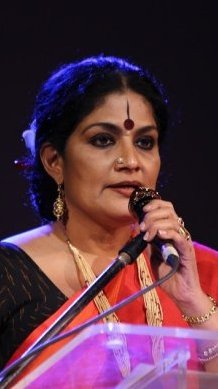 Geeta Chandran 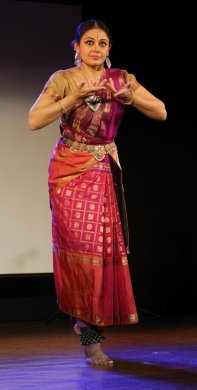 Shobana The final session was by Shobana, the celebrated actor, dancer, choreographer and teacher. The session was devised as conversation between Professor Kaladharan of Kerala Kalamandalam and Shobana. Asked about how abhinaya for films and dance differed and what she preferred as a dancer, she explained that once the film shooting is over the abhinaya remains recorded, whereas on stage one has to be ready for registering abhinaya with great care as dance is an occurring art. About why she uses ghana raga like Shankarabaranam for tillana, she said she prefers these ragas and did not know more about rakti ragas. Audience being familiar with her favourite Pahadi tillana, she with help of her disciple showed few examples and herself danced excerpt of a tillana. She finds Kshetrayya padams challenging to perform, for its shringara and its physicality. Her rendition of javali "Smarasundara" was well received. With her commanding stage presence and natural gifts, she presented it with finesse. She said that dance is probably a way of life and that its true worth in her life she would perhaps realize only when it ceases to be there. A versatile artist she prefers sopanam music for Mohiniattam. She prefers to perform Swati Tirunal's compositions. Kaladharan referred to late Kavalam Narayana Panicker's attempt to popularise it as suitable music for Mohiniattam. Shobana firmly believes that classical dance is meant for initiated audiences and a dancer has to maintain high standards. Teaching young dancers has helped her a lot and she believes that it is important to teach whereby a dancer learns a lot. The conference concluded with presentation of awards to the best school that sent students daily for conference, also to some young participants who asked relevant and important questions. Srinidhi and Aalap team had approached few school principals and arranged for transport for young dancers to attend. From Kalakshetra a large number of students attended the conference daily. Such initiatives were much appreciated. As a result of these efforts a large number of young dancers attended the conference and it succeeded in exposing the young generation to seniors, for them legendary dancers, several issues, challenges and interaction with scholars, critics, dance gurus. The Sthiti Gati booklet contains introductions of the participants and their interviews edited by Srinidhi Chidambaram and conceived by Aalaap. It is a collector's item and very useful for all interested in dance. Srinidhi, Akhila Krishnamurty and team of Aalaap, Y. Prabhu and Sri Krishna Gana Sabha, all worked together to make the conference a great success. In its time frame of 36 years, the 36th Natya Kala Conference has left a bench mark for the diverse topics, concentrating on one form Bharatanatyam, bringing legendary dancers, several gurus, institutional heads, luminaries and a galaxy of artists on one platform. Though it was difficult to maintain time limit often, the conference offered lots of things to mull over. I am confident that next year the conference will draw larger crowds and fulfil its purpose as it did this year.  Dr. Sunil Kothari is a dance historian, scholar, author and critic. He is honored with Padma Shri, Sangeet Natak Akademi award and Senior Critic Award from Dance Critics Association, NYC. Post your comments Please provide your name and email id when you use the Anonymous profile in the blog to post a comment. All appropriate comments posted with name & email id in the blog will also be featured in the site. |